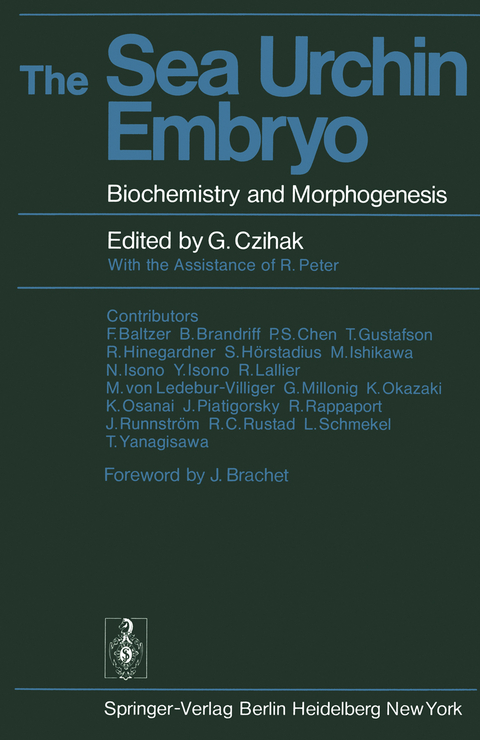
The Sea Urchin Embryo
Springer Berlin (Verlag)
978-3-642-65966-9 (ISBN)
1. Introductory History.- 2A. Care and Handling of Sea Urchin Eggs, Embryos, and Adults (Principally North American Species).- 2A.1 Collecting and Keeping.- 2A.2 Spawning Season.- 2A.3 Determining Sex.- 2A.4 Obtaining Gametes.- 2A.5 Preparing Eggs.- 2A.6 Counting Eggs.- 2A.7 Storing Gametes.- 2A.8 Agents Affecting Development.- 2A.9 Choosing Eggs.- 2A.10 Fertilization.- 2A.11 Removing Extracellular Structures.- 2A.12 Normal Development.- 2B. Handling Japanese Sea Urchins and Their Embryos.- 2B.1 General Handling.- 2B.2 Echinoids as Experimental Materials.- 2B.3 Maintenance.- 2B.4 Sexual Dimorphism.- 2B.5 Artificial Spawning.- 2B.6 Gametes.- 2B.7 Artificial Fertilization.- 2B.8 Development and Growth.- 2C. Maturation Periods of European Sea Urchin Species.- 3. Gametogenesis.- 3.1 Gonad Biology.- 3.2 Germ Cells.- 3.3 Immature Gonads.- 3.4 Spermatogenesis.- 3.5 Oogenesis.- 3.6 Conclusions.- 4. Fertilization.- 4.1 Activity of Spermatozoa.- 4.2 Acrosome Reaction.- 4.3 Spermatozoon Penetration.- 4.4 Partial Fertilization.- 4.5 Egg Activation by Sperm Injection.- 4.6 Sperm Role in Egg Activation.- 4.7 Egg Cortical Response.- 4.8 Narcotized Egg Responses.- 4.9 Refertilization and Polyspermy.- 4.10 Conclusions.- 5. Parthenogenetic Activation and Development.- 5.1 Ways of Inducing Parthenogenetic Development.- 5.2 How Parthenogenetic Activation Works.- 5.3 Conclusions.- 6. Cytology of Parthenogenetically Activated Sea Urchin Eggs.- 6.1 Monaster Formation.- 6.2 Cytaster Formation.- 6.3 Karyogene Spindle Formation.- 6.4 Haploid Mitosis.- 6.5 Combinations.- 7. Normal Development to Metamorphosis.- 7.1 Cleavage Stage.- 7.2 The Blastula before Hatching.- 7.3 The Blastula after Hatching.- 7.4 Gastrula Stage.- 7.5 Prism and Pluteus Stages.- 7.6 Late Larval Stage and Metamorphosis.- 8. Cellular Behavior and Cytochemistry in Early Stages of Development.- 8.1 The Sea-Urchin Embryo in Studies of Morphogenetic Cell Behavior.- 8.2 Morphogenetic Cell Behavior Analysis.- 8.3 Cleavage and Blastula Formation.- 8.4 Morphogenetic Cell Behavior in the Ectoderm.- 8.5 Morphogenetic Cell Behavior in the Mesendodermal and Mesenchymal Region.- 8.6 Cytologic Aspects of Filopodal Attachments.- 8.7 Morphogenetic Cell Behavior during Further Development of the Mesendoderm.- 8.8 Biochemical Differentiation of the Blastula and Gastrula.- 8.9 Biochemical Activity and Morphogenetic Movement.- 9. Egg and Embryo Ultrastructure.- 9.1 The Mature Egg.- 9.2 The Mature Spermatozoon.- 9.3 Fertilization.- 9.4 Pronuclear Development and Fusion.- 9.5 Mitosis.- 9.6 From 2-Cell Stage to Gastrula.- 10. The Biophysics of Cleavage and Cleavage of Geometrically Altered Cells.- 10.1 General.- 10.2 Cleavage Theories.- 10.3 Biophysics of Cleavage.- 10.4 Cleavage Pattern Alteration.- 10.5 Summary.- 11. Centrifugation and Alteration of Cleavage Pattern.- 11.1 Techniques.- 11.2 Morphological Changes.- 11.3 Electron Microscope Studies.- 11.4 Developmental Patterns.- 11.5 Cleavage Patterns and Micromere Formation.- 11.6 Development of the Dorso-Ventral Axis.- 11.7 Respiration.- 11.8 Biochemistry.- 12. Irradiation, Chemical Treatment, and Cleavage-Cycle and Cleavage-Pattern Alteration.- 12.1 Stimulation of Premature Division.- 12.2 Division Delay.- 12.3 Division Abnormalities.- 12.4 Early Post-Fertilization Changes.- 12.5 The General Cell Cycle.- 12.6 DNA Synthesis.- 12.7 RNA Synthesis.- 12.8 Protein Synthesis.- 12.9 Pronuclear Fusion.- 12.10 Duplication and Separation of Centrioles.- 12.11 Chromosomal Condensation and Nuclear Membrane Breakdown.- 12.12 Metaphase, Anaphase, and Telophase.- 13. Isolation and Transplantation Experiments.- 13.1 Methods.- 13.2 Determination of Cleavage.- 13.3 Determination along the Egg Axis.- 13.4 Dorsoventral Axis Determination.- 13.5 Interactions between Species.- 13.6 Fragments Used for Physiological Tests.- 14. Blastomere Reaggregation.- 15. Morphology and Biochemistry of Diploid and Androgenetic Haploid (Merogonic) Hybrids.- 15.1 Classification.- 15.2 Hybrid Fertilization Techniques.- 15.3 Early Development of Parental Species.- 15.4 Developmental Capacity and Morphologic Characteristics of Hybrids.- 15.5 Biochemical Properties of Hybrids.- 15.6 Conclusions.- 16. Animalization and Vegetalization.- 16.1 Introduction.- 16.2 Definitions.- 16.3 Experimental Methods.- 16.4 Vegetalizing Agents.- 16.5 Animalizing Agents.- 16.6 Research on the Metabolism of Animalized and Vegetalized Larvae.- 16.7 Biophysical Aspects.- 16.8 Concluding Remarks.- Addendum.- 17. Respiration and Energy Metabolism.- 17.1 Overall Changes in Respiration during Development.- 17.2 Increased Respiration after Fertilization.- 17.3 Respiratory Change after Fertilization.- 17.4 Respiratory Increase during Development; Energy Metabolism.- 17.5 High-Energy Phosphate Compounds and Their Metabolic Activity.- 18. Carbohydrate Metabolism and Related Enzymes.- 18.1 Glycolysis and the Pentose Phosphate Shunt.- 18.2 Pyruvate Metabolism and the Tricarboxylic Acid (KREBS-) Cycle.- 18.3 Terminal Electron Transport System.- 19. Lipids.- 19.1 Lipids in General.- 19.2 Phospholipids.- 19.3 Glycolipids.- 19.4 Cholesterol.- 19.5 Carotenoids.- 19.6 Lipid Metabolism.- 20. DNA in Gametes and Early Development.- 20.1 DNA in Gametes.- 20.2 DNA Synthesis during Development.- 20.3 Enzymes.- 21. Integrating Factors.- 21.1 Organization of Egg Cytoplasm.- 21.2 Differentiation along the Egg Axis.-21.3 Integration of DNA and Nuclear Protein.- 21.4 Differentiation along the Dorsoventral Axis.- 21.5 Summary.
| Erscheint lt. Verlag | 7.12.2011 |
|---|---|
| Co-Autor | R. Peter, F. Baltzer |
| Vorwort | J. Brachet |
| Zusatzinfo | XX, 702 p. |
| Verlagsort | Berlin |
| Sprache | englisch |
| Maße | 170 x 244 mm |
| Gewicht | 1232 g |
| Themenwelt | Medizin / Pharmazie |
| Naturwissenschaften ► Biologie ► Genetik / Molekularbiologie | |
| Naturwissenschaften ► Biologie ► Zellbiologie | |
| Schlagworte | biochemistry • Biology • chromosome • classification • Development • Embryology • Membrane • Metabolism • Morphogenesis • Morphology • Oogenesis • RNA • Sex • Spermatogenesis • System |
| ISBN-10 | 3-642-65966-7 / 3642659667 |
| ISBN-13 | 978-3-642-65966-9 / 9783642659669 |
| Zustand | Neuware |
| Haben Sie eine Frage zum Produkt? |
aus dem Bereich


